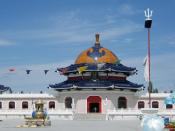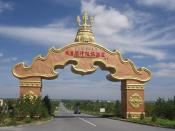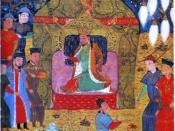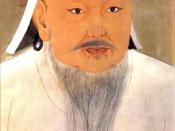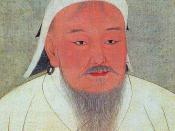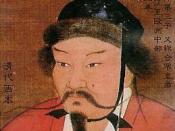The Mongolian army was unstoppable in the eyes of their enemies. They are swift and ferocious, yet at the same time are mobile and capable of wearing out armies that are greater in numbers than them. It is true that the Mongolian army was open-minded to new tactics on the battlefield as well as adaptive to different situations, but that alone does not account for their military superiority. Together with the superior quality of each of its individual soldiers in terms of discipline, weapons and combat skills, the Mongolian army was able to take on larger and more disciplined armies from larger civilizations.
The Mongols are basically nomads, roaming the steppe-desert world and moving from oasis to oasis. They rely heavily on their horses and take what they need from agricultural areas along their borders or raid trade caravans that ply the trade routes in their domains. The luxurious goods like silk, trinkets and gold that they plundered would be used to trade for their daily necessities or equipments in markets.
They are also known to pillage and plunder farming communities along the borders of their sedentary, civilized neighbors using lightning fast 'hit-and-run tactics' (Murphey 202).
The mobile nature of their armies led to their unpredictability, giving them the upper hand in conducting fast raids or if needs be, to outwit and outrun their opponents. The key to such mobility is the Mongolian pony. The mounts on the Mongolian army do not require grain and stabling like their European charger counterparts (Nell). In times of warfare, each warrior also has a few spare mounts that he could change once the current one got tired. This way, the Mongolian army could travel at great speed and cover great distance as much as up to 100 kilometers in a single day (Nell). This is especially useful because it shows that the Mongolian army is able to win its enemies in terms of speed, thus opening up many possibilities in terms of tactics. One of them is the feigned retreat known as the mangudai (Trombetta).
The mangudai was popularly used in war campaigns because it is able to lure enemy troops away from their base into the wild steppes into a pre-arranged location (Tromebetta). At the pre-arranged location, the light cavalry would change into fresh mounts while the enemies follow straight into an ambush of hidden cavalry archers. With fresh mounts, the light cavalry would encircle the flanks of the enemies who by this time, are tired and weary and far from supplies. At this moment, the heavy cavalry would charge in and disperse the formation of the enemy, cutting and swathing through a path of blood. Such tactics are effective partly because great generals like Subodai and Jebe exists and are able to plan and execute them at the right moments.
The Mongols are also amazing at adapting to new environments. Perhaps it is due to their upbringing as nomads in the steppes that taught them the importance of adapting. Under such environments, only those who adapt and compromise with what they have are able to survive. Hunting in the steppes requires Mongolians hunters to quickly surround and shoot at herds of game. On the battlefield, the Mongolian armies adapted this technique into a battle tactic, the mangudai. Change also does not surprise them anymore since they are so used to traveling and looking at different environment as the seasons change.
The great Mongolian leader Genghis Khan also understood the importance of having spies and informants in the courts of his enemies even though he grew up in the steppes. He recruited many through briberies with gold and this allowed him to have a better understanding of his enemies. This is similar to the technique of scouting used while hunting. Men would be dispatched to encircle a smaller and smaller area, taking care not to allow any hunted animals to break through the ring, until it was time for the final slaughter. The use of the spy in international relations and military operations, therefore, may represent the outgrowth of activities that were common in traditional Mongol society (Trombetta).
In another example of Mongolians adapting to new environments and overcoming obstacles would be the invasion of China during the Song Dynasty. In the steppes, fighting is done usually with units of heavy and light cavalry, since naval or infantry units are ineffective in such a vast, dry desert. However, to invade China, the Mongolian army would have to cross the Yangtze River as well as many other bodies of water. Thus, cavalry alone was not effective in the invasion. Genghis Khan knew this and to adapt, he made use of naval and amphibious operations that are more effective on China's terrain.
He also ordered the construction of great artilleries even though they were of no use in the steppes. However, the kibitka, a light catapult used for launching javelins or the trebuchet-like catapult that launch rocks, as well as the ballistae, which could launch huge arrows 320 metres far, were used to rain devastation on city walls of their enemies.
By being open-minded and willing to change, Genghis Khan successfully conquered most of China.
Horses were highly revered in Mongolian society. Every Mongolian practically spent most of their lives on the saddle. When they were infants, they were tied to a board which was in turn tied to the tail of their mother's horse. At the age of three, they were fastened to the saddle of their own horse. By age four to five, they were given bows and are taught to hunt on horsebacks (Trombetta). Such arduous upbringing transformed boys into fearsome warriors skilled on horse as well as the bow.
As adults, Mongols of different tribes engage in 'steppe hunts' which includes skirmishes between tribes due to various political reasons amongst themselves. There is a certain degree of political activity amongst tribes as tribes are bound to meet each other and vie for territory or grazing lands in their seasonal roaming around the steppes. Growing up such harsh environments of the steppes and being constantly on the move from one place to another in search of food and water made the Mongols a hardy race and together with their upbringing, produced warriors that adhere to a 'survival of the fittest' way of life, especially on the battlefield. Thus, at the individual level, Mongolian soldiers are hardier and stronger in comparison to their European or Chinese counterparts since they easily adapt to their surroundings as well as being skilled in combat since young.
The Mongolian army is organized into groups of 10, 100, 1000 and 10000 soldiers. 10 soldiers make up an arban, 10 arban makes a squadron of 100 soldiers called jaghun. 10 jaghun makes a regiment of 1000 soldiers called mingghan. 10 mingghan makes a 10000 strong unit of a tjumen. A large army usually consists of 3 tjumens, with one skilled in close-quarter combat and the other 2 tjumen consisting of cavalries to encircle the enemy (Nell). Despite being made up of various different tribes, the Mongolian Army is able to co-operate with each other and this showed discipline among the ranks. On the battlefield, signals are given by banners, beating the kettle or by smoke signals (Oestmoen). They are also known for their amazing ability to coordinate attacks without uttering a sound. Such a high level of discipline is also what made the Mongolian army so sturdy in the face of adversities.
There were two major types of soldiers. One of them was basically lightly equipped bowmen that rode Mongolian Ponies and wore leather armor. They mainly use the formidable Mongolian composite bow that is made of sinew and horn as well as a lighter Recurved bow that could be fired rapidly from horseback. The heavier Composite bow was used for long-ranged attacks and usually from ground position. It was the most formidable ranged weapon at that age because it even surpasses the range of the English Longbow by 100 meters. Then there were more heavily armored soldiers in composite armor made of metals and hardened leather. In addition to bows, these men carried a circular shield and hooked lance used for dragging enemies from the saddle. They also used a sword or mace for close quarter combat.
The Mongolian soldiers were issued standard silk underwear. This is clever because silk is a tough substance and if shot from a long distance, the arrow may not necessarily penetrate the skin. Even if the arrow does penetrates the skin, the arrow could be drawn out easily by just pulling the silk out. Poison could also be prevented from entering the bloodstream. Even though Mongolian attire are suitable for their dry and hot desert climate, they quickly adapted to the cold surroundings when invading Siberia, which could get as low as 60 degrees Celsius below the freezing point. Thus the Mongols used heavy leather boots with felt socks on their feet. During winter they wore on their bodies several layers of wool. On the outside they typically had a covering coat of fur or sheepskin, and a fur hat with ear flaps over the helmet.
The principle of independence and self-sufficiency is extremely important to the Mongols and this was applied to as far as possible to the individual warriors. A full set of tools and spare parts are standard issue for each soldier; a lasso, a kettle, a bony needle and sinews (Oestmoen). There would be a waterproof pouch used to keep his rations of dried meat and fermented milk as well as his attires dry. It is also especially useful when crossing rivers. They would tie all their equipments to the horses and swam together with the animals. Unlike their "civilized" enemies, the Mongolians would never detour probably hundred of miles just to find a bridge to cross a river. Their enemies are too sedentary and dependent on bridges that their willingness to adapt to their surroundings was dulled (Macpherson).
As could be seen, there is relative independence in the individual soldier, the units and their leaders. Each of these have to cooperate and coordinate large scale attacks or formations but each soldier or unit must also be to exist and survive independently. In other words, there was never any dependence on a central unit for the function of all (Oestmoen). The extensive collection of equipment carried by each individual soldier is testimony to the emphasis laid upon this vital combination of capability of joint engagement on the one side, and capability of independent action and a high degree of individual self-sufficiency on the other.
Thus, in terms of equipment, logistics, mobility, communication, discipline and command, the Mongol army was not to be surpassed until the modern age. The quality of each individual Mongolian soldier surpassed each of their Western counterparts by leaps and bounds. Throw in their ability to adapt to any situation and we have the most fearsome warriors that conquered the largest contiguous land area known in mankind's history.
Works Cited1) Macpherson, Catriona "Nomads or Barbarians?" The Dark Horde 2) Murphey, Rhoads A History of Asia 5th Edition United States: Pearson Education Inc, 20063) Nell, Grant Sebastian "The Mongolian War Machine" suite101.com 27 Aug 2008 4) Oestmoen , Per Inge "The Mongol military might" The Realm of the Mongols 18 Jan 2002 < http://www.coldsiberia.org/monmight.htm>5) Trombetta , John J. and Steven C. Ippolito "The Emergence of Seapower in the Yuan Dynasty: The Transformation of Mongol Warfighting through a Revolution in Military Affairs (1258-1281)" MilitaryHistoryOnline.com 24 Dec 2007
